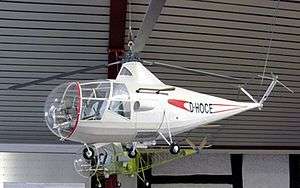Borgward Kolibri
| BFK-1 Kolibri | |
|---|---|
 | |
| Model of the Borgward-Focke BFK-1 Kolibri at the Bückeburg Helicopter Museum | |
| Role | Utility helicopter |
| National origin | German |
| Manufacturer | Borgward |
| First flight | July 8, 1958 |
|
| |
The Borgward BFK-1 Kolibri, aka Borgward-Focke BFK-1 Kolibri, (Kolibri meaning "hummingbird" in German) was a German three-seated utility helicopter built by Borgward, designed by Heinrich Focke. It was the first German helicopter after World War II.[1] The helicopter first flew on July 8, 1958 in Bremen, piloted by Ewald Rohlfs.[2] Two prototypes were built. The helicopter had a steel tubing fuselage, and was covered with metal. It had a fabric-covered v-tail the end of which would have rotors. The main rotor had three blades with steel tubing for the centre, covered with wood. The helicopter had a six-cylinder air-cooled Lycoming VO-435-A1B engine, producing 260 hp.[3] The fuel tank was capable of holding 180L. The helicopter could be used for spraying in agriculture, and could carry up to 300 lbs. Development ended after the two prototypes, as Borgward went bankrupt shortly after in 1961.[4]
Specifications
General characteristics
- Crew: 1
- Capacity: One pilot, two passengers
- Length: 8.3 m (27 ft 3 in)
- Height: 3.05 m (10 ft 0 in)
- Empty weight: 800 kg (1,764 lb)
- Max takeoff weight: 1,200 kg (2,646 lb)
- Fuel capacity: 180L
- Powerplant: 1 × Lycoming VO-435-A1B air-cooled six-cylinder, 190 kW (260 hp)
- Main rotor diameter: × 9.4 m (30 ft 10 in)
Performance
- Maximum speed: 160 km/h (99 mph; 86 kn)
- Cruising speed: 140 km/h (87 mph; 76 kn)
- Range: 322 km; 174 nmi (200 mi)
- Service ceiling: 4,500 m (14,764 ft)
Notes
- ↑ Aeroplane and commercial aviation news. 99: xlix. 1960. Missing or empty
|title=(help) - ↑ Lambermont, Paul Marcel; Anthony Pirie (1970). Helicopters and autogyros of the world. Barnes.
- ↑ Royal Aero Club of the United Kingdom, United Service and Royal Aero Club (1959). Flight International. IPC Transport Press Ltd. 75: 685. Missing or empty
|title=(help) - ↑ Aviation Week & Space Technology. McGraw-Hill. 74: 32. 1961. Missing or empty
|title=(help)
References
- Green, William (1961). The Observer's World Aircraft Directory. F. Warne. p. 142.